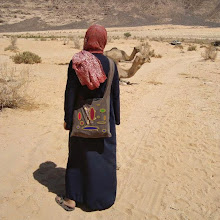For the past two weeks, I've been participating
in a yoga teacher training course at Kripalu, a retreat center in Western
Massachusetts. The yogic tradition fascinates me because it is being
embraced in its modern form by so many people from my background - European -
American - educated - middle - upper middle class - and also because of the
fear that yoga invokes in some interpretations of Islam that I’ve come across
in Jordan. The month long course, split into two two week sessions,
allows me to gain a fuller understanding of how yoga is taught, to developing
greater physical awareness and also to gain skills that will allow me to offer
a holistic approach in personal growth and development to my students.
Now - what have I found?
The first week of the course, one of my
teachers said to me: "The practice of a renunciate is not the
practice of a householder."
When I first heard this statement, my mind jumped
immediately to a comparison of the physical practices of Islam and yoga.
As a yogi at Kripalu, I am expected to engage in nearly four hours of
physical practice per day. As a Muslim anywhere in the world, the
physical requirement of worship is five daily prayers which at a minimum add up
to 30 minutes of physical movement. In my mind, yoga at Kripalu offers a
physical practice for a renunciate while Islam, with no monastic tradition,
calls for a world of householders and offers a subtle yet powerful physical
practice. I should also clarify that while Muslim prayer is a clearly
defined devotional act, physical yoga practice at Kripalu is an exercise
designed to promote health and wellness. Islam externalizes that which we
worship, Kripalu yoga internalizes it. Note also that while Islam is submission
to the will of God, yoga in the original Vedic Sanskrit expresses union,
connection, addition and joining together.
The morning after receiving the above statement,
I emerged from a deep, hour and forty five minute physical practice with my
head in the clouds, feeling a desire to stay there - avoiding the people around
me and their apparent quirks - I've discovered that when my mind is quiet, I
can often pick up on the louder thoughts and feelings of those around me - for
better or for worse :) The hour plus period between the end of morning
yoga and the first class is held in silence and on my way to breakfast, I found
myself dodging gazes, interactions and greetings. I appreciated my
alone-ness though simultaneously feeling awkward and a bit guilty
for withholding my greetings to other souls.
How do we greet others from a place of silence?
I reflected. Can we truly live a full life if we avoid interactions with
other people?
Though a bit of peace felt good as I ate
breakfast (during which I chose not to have eggs because they seemed too
loud!), I found myself slowly waking up to the physical world around me -
the place where humans live and learn, exist and embrace our lives.
After this experience, I felt that the physical
yoga practice I had engaged in created an over emphasis on the
individual and a forgetfulness of the human community - which makes some
sense - if one spends four hours a day in an intense individual practice.
As I have learned more about yoga, particularly some of the elements that
dictate how a yogi interacts with other humans, I recognize that though modern
yoga does place emphasis on the individual, the community is not forgotten.
It is simply the case that yoga as an individually oriented practice
dictates the expectations of a renunciate as he or she develops him or
herself within a spiritually conscious community. Although most
practitioners of yoga in the US today are not renunciates, I’ve come to believe
that the individual oriented nature of the practice is more resonant in a
society that emphasizes the individual and his or her experience.
Islam, as I have experienced it in Jordan, in
contrast, meets the needs of a householder within a greater community of
spiritually dedicated Muslims. The five prayers bookend the day. We
rise and breakfast at dawn (fair) and spend the morning engaged in work, dhuhr
is prayed at mid-day, followed by lunch and rest-time through early afternoon,
when asr is prayed. After the asr prayer, errands and visits are
performed through sunset and the maghrib prayer and dinner is followed by a
reasonably early bedtime after people pray ishaa. Prophet Mohammed's
statement that the best thing in a righteous life is a righteous spouse
recognizes the unity that can exist between two humans dedicated to building a
life together and the idea that Islam is a surrender not only to God but also
to one's place in the human community.
Ultimately, one chooses a path that is most
relevant to one's life and as the tide of the human experience changes, we move
on from practices that do not adapt to meet the needs of our environment.
I believe that yoga is gaining footing in North America and Europe because
it offers a deeply physical element to a largely desk-bound population, while
also offering a secular framework to those who have distanced themselves from
conventional religion. The deep family oriented nature of dominant interpretations of Islam today thrives
in regions where family bonds reinforce the religious teachings of the Prophet
and vice versa. Simultaneously, as environmental factors such as material
wealth and government regulation increase in Muslim societies, family bonds and
people's approach along with them evolve and change.
Faith and its practice are as dynamic in the
world in which we experience them.
 |
| Elements of Muslim Prayer |
